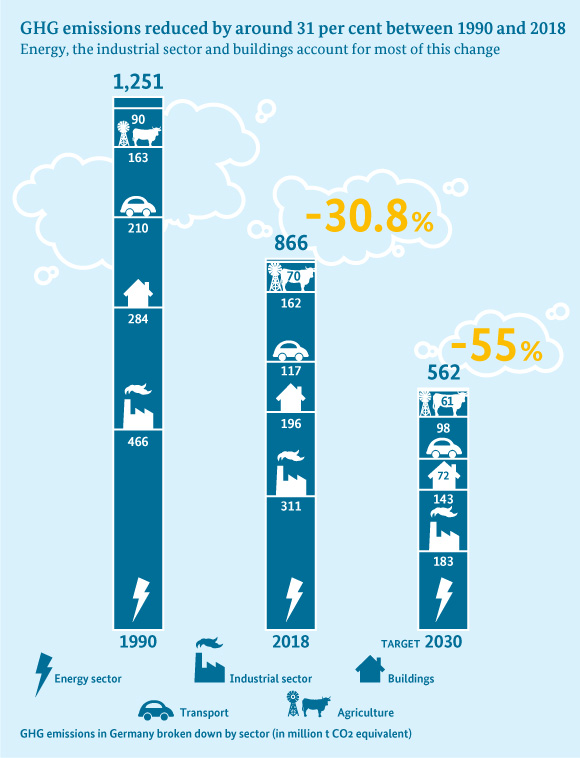Three sectors contributing to the fall in GHG emissions
Initial estimates suggest that greenhouse gas emissions continued to fall in Germany in 2018. According to these estimates, GHG emissions decreased by 31% compared with 1990 levels. Which sector has contributed how much to this result? And what are Germany and the EU aiming to do to further reduce emissions in the future?
 © BMWi; data from: Climate Action Plan 2050, Federal Environment Agency 2019
© BMWi; data from: Climate Action Plan 2050, Federal Environment Agency 2019
According to preliminary figures released by the Federal Environment Agency, Germany cut its annual greenhouse gas emissions by 31 per cent between 1990 and 2018. The largest share of this is due to considerable reductions in GHG emissions in the buildings sector (minus 44 per cent), the energy sector (minus 33 per cent), and the industrial sector (minus 31 per cent). In contrast to this, GHG emission reductions in agriculture and especially the transport sector remained below expectations, at minus 22 and minus 1 per cent respectively. In total, 866 million tonnes of CO2 equivalent were released in Germany in 2018. That is 385 million tonnes less than in 1990. The CO2 equivalent (CO2-eq) is a measure used to compare the emissions of the seven different greenhouse gases (of which CO2 is one) based upon their global warming potential.
Buildings, energy and the industrial sector
The energy sector accounts for most of the total reductions of 385 million tonnes, with GHG emissions in this sector falling by 155 million tonnes between 1990 and 2018. That is around 40 per cent of Germany’s total reductions. Emissions in the buildings sector and industry fell by 93 million (around 24 per cent less) and 88 million (around 23 per cent less) respectively. When looking at these figures, one has to consider the fact that Germany’s total GHG emissions in 1990 included the emissions from the former GDR’s carbon-intensive power plants and factories.
Germany seeks to become almost carbon neutral by 2050
As set out in the Energy Concept of 2010, the Federal Government seeks to reduce emissions by at least 55 per cent by 2030 compared with 1990 levels (by at least 70 per cent by 2040 and by at least 80 to 95 per cent by 2050). In order for this to be achieved, Germany needs to reduce its annual emissions by another 304 million tonnes of carbon dioxide equivalents.
The Federal Government plans to decide before the end of 2019 what action it will take to meet the reduction target for 2030. The responsible ministers from five ministries, the chancellor and the finance minister meet regularly in the cabinet committee on climate change mitigation – which has been set up especially for this purpose – to discuss the progress achieved and the measures to be taken. The first meetings were held in April and May of this year.
EU greenhouse gas emissions fall by 22 per cent compared with 1990 levels
The measures identified by the committee will be included in the final version of Germany’s National Energy and Climate Plan (NECP), that the Federal Government and all other European Member States need to submit to the European Commission by the end of the year. The European Commission uses the NECPs to assess whether the measures taken by each Member States are sufficient to meet the climate targets at union level.
These include plans to reduce greenhouse gas emissions by 40 per cent by 2030 compared with 1990 levels, and by 80 to 95 per cent by 2050. Taken together, the European Member States reduced their combined emissions by around 22 per cent between 1990 and 2017. The European Statistical Office (Eurostat) has already published some preliminary figures on carbon emissions from fossil fuel combustion for 2018. These suggest that the EU reduced its carbon emissions by another 2.5 per cent over the previous year.

